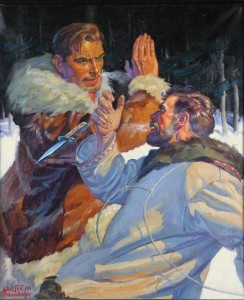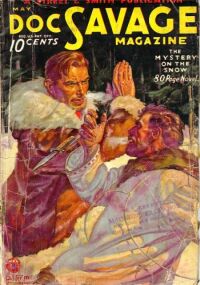
Walter M. Baumhofer (1904-1987)|Mystery on the Snow, c. 1934|Cover illustration for "The Mystery on the Snow" by Kenneth Robeson (Lester Dent) for Doc Savage Magazine (May 1934), later published as Book 15 in the Doc Savage series (1934) with a different Baumhofer painting on the paperback cover.|Oil on canvas|Collection of Society of Illustrators, 083.031
The strong, tanned, clean-shaven countenance doing battle in the snow is Doc Savage, whose bronze skin, golden eyes and bronze hair were the reason for the appellation, “Man of Bronze.” Clark Savage, Jr., a.k.a. Doc Savage, was a fictional heroic-adventure character published in the 1930s and 40s, created by Henry W. Ralston and John L. Nanovic of Street and Smith Publications. The main author of the story series was Lester Dent (1904-1959), who composed his work under the name, Kenneth Robeson. The publisher offered Doc Savage stories in 181 issues of the Doc Savage Magazine.
Illustrator Walter M. Baumhofer was the creator of many of the early covers of the Doc Savage series. In 1922 he won a New York city-wide poster contest which earned him a scholarship to Pratt Institute where he studied under Dean Cornwell and H. Winfield Scott. While still in school, Baumhofer began producing ink illustrations for Adventure magazine stories. By 1926 he had sold his first pulp cover. Soon Baumhofer became a dominant force in the pulp-magazine market, creating over 1500 illustrations. Baumhofer’s extremely successful pulp image career lead him to be known as the “King of Pulps.” In 1937 he joined the American Artists agency and began to sell freelance illustrations to a variety of popular magazines known as slicks*, such as Cosmopolitan, Redbook, and Colliers. By the 1950s, Baumhofer switched to illustrating men’s adventure magazines such as True, Outdoor Life, and others.
The fictional character Doc Savage was a brilliant scientist with a photographic memory who had been trained from birth to fight evil. Author Lester Dent described Doc as a cross between “Sherlock Holmes with his deducting ability, Tarzan of the Apes with his towering physique and muscular ability, Craig Kennedy with his scientific knowledge, and Abraham Lincoln with his Christliness.”** Doc’s personal oath expresses his character and his world view:
Let me strive every moment of my life to make myself better and better, to the best of my ability, that all may profit by it. Let me think of the right and lend all my assistance to those who need it, with no regard for anything but justice. Let me take what comes with a smile, without loss of courage. Let me be considerate of my country, of my fellow citizens and my associates in everything I say and do. Let me do right to all, and wrong no man.
Doc’s companions on his adventures are five accomplished individuals: Lieutenant Colonel Andrew Blodgett “Monk” Mayfair, an industrial chemist; Brigadier General Theodore Marley “Ham” Brooks, an attorney; Colonel John “Renny” Renwick, a construction engineer; Major Thomas J “Long Tom” Roberts, an electrical engineer; and William Harper “Johnny” Littlejohn and archaeologist and geologist.
Adventure characters and super heroes, like Doc Savage, The Shadow, Superman, and Batman, exploded in American culture in the 1930s when hope was in short supply. With more brains and physical strength than the rest of the human race, these super characters conquered foes and eradicated evil, in so doing they provided a positive and uplifting focus for every day people.
In this adventure, “Mystery on the Snow,” Doc journeys north to a Canadian winter wilderness to solve a billion-dollar riddle: Who or what has committed murder in an attempt to possess the secret of the miracle called Benlanium? In the snow country Doc, his companions, and the beautiful, desirable Canadian detective Midnat D’Avis, battle the forces of evil and a gang of French-Canadian thugs to find Doc’s friend Ben Lane and to secure Lane’s discovery – a mountain of Benlanium.
Baumhofer’s terrific cover image for this story is a focused look at Doc battling one of the minions of evil. Baumhofer understood how to get the most information across about a story through the close up of an active scene. The cool, unruffled, and handsome Doc Savage is clearly winning this confrontation. A puff of heated air explodes from his enemy’s mouth as he stumbles backward in contrast to the unhurried unmarred visage of Doc Savage. Baumhofer used violet blue shadows in and on the white of the enemy’s parka in contrast to the cool green shadow tones in the white fur of Doc’s parka reinforcing the cool action of the hero. Doc’s chiseled bronze features are framed by the dark evergreens behind him, while the falling enemy’s body is embraced by the white of the snow-covered landscape. Is there any question that Doc will win this confrontation?
Tune in again next week.
*A popular magazine printed on coated paper stock and intended to appeal to sophisticated readers.
** https://thepulp.net/docsavage.html A professor of chemistry, Craig Kennedy was a scientific detective who used his knowledge of chemistry and psychoanalysis to solve cases. He also utilized scientific devices which were at that time considered exotic (lie detectors, gyroscopes, and portable seismographs) in the solution of his work. Kennedy became the prototype for American scientific detectives and their adventures.
March 4, 2010
By Joyce K. Schiller, Curator, Rockwell Center for American Visual Studies
at the Norman Rockwell Museum







